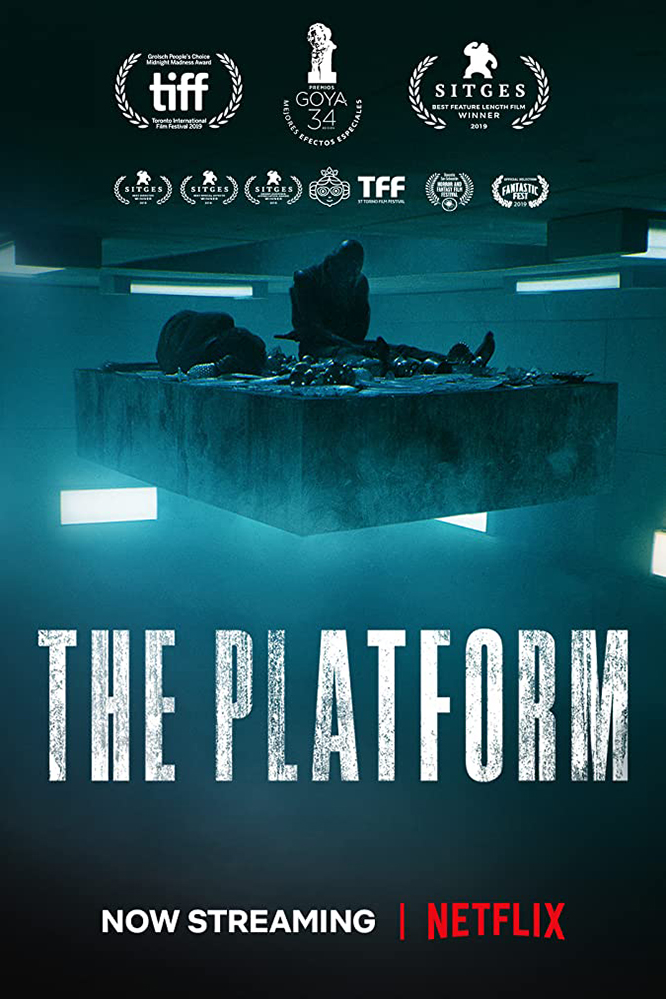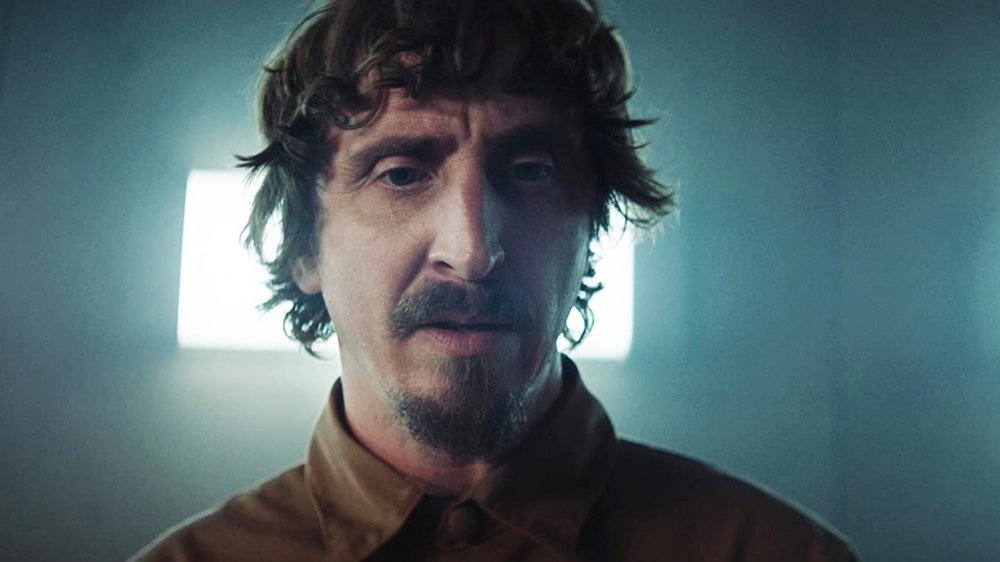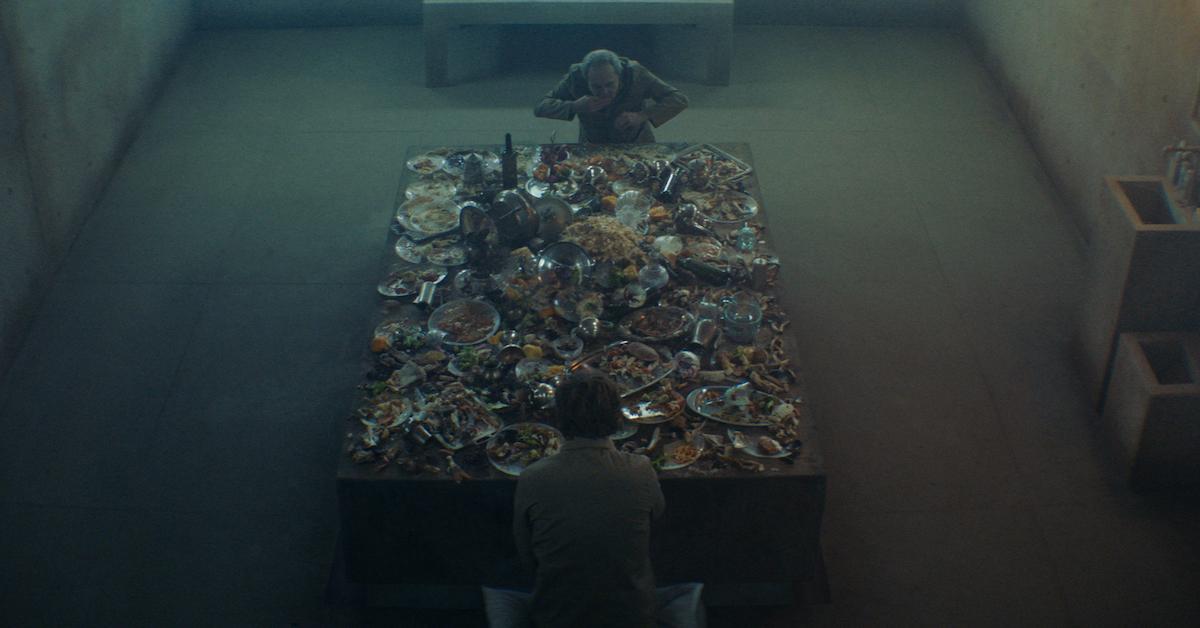 The Platform, directed by Galder Gaztelu-Urrutia and released in 2019, is a dystopian thriller that delves into the complexities of human nature, class disparity, and the struggle for survival. The narrative unfolds within a vertical prison known as “The Hole,” consisting of numerous levels stacked on top of each other. Each level has two occupants, and a platform laden with food descends from the top to the bottom, providing sustenance for a limited time.
The Platform, directed by Galder Gaztelu-Urrutia and released in 2019, is a dystopian thriller that delves into the complexities of human nature, class disparity, and the struggle for survival. The narrative unfolds within a vertical prison known as “The Hole,” consisting of numerous levels stacked on top of each other. Each level has two occupants, and a platform laden with food descends from the top to the bottom, providing sustenance for a limited time.
Goreng (Iván Massagué), the protagonist, awakens on Level 48, accompanied by Trimagasi (Zorion Eguileor), his cellmate. As the platform descends, the two prisoners discover that those on higher levels feast on the available food, leaving little to nothing for those below. The platform stops on each level for a predetermined amount of time, leading to a tense and often brutal struggle for survival among the inmates.
The film’s allegorical nature becomes evident as Goreng navigates the challenges presented by the hierarchical structure of The Hole. Themes of greed, solidarity, and the impact of systemic inequality are explored through the characters’ interactions and the consequences of their choices. As Goreng descends through the levels, encountering different characters and facing increasingly dire circumstances, the film builds towards a climactic and thought-provoking conclusion.
Characters
Goreng (Iván Massagué): Iván Massagué portrays the main character, Goreng, who serves as the audience’s guide through the harrowing environment of The Hole. Goreng’s journey becomes a metaphorical exploration of morality and resistance in the face of a dehumanizing system. Massagué’s performance effectively conveys the evolution of Goreng from a bewildered newcomer to a determined advocate for change.
Trimagasi (Zorion Eguileor): Zorion Eguileor plays Trimagasi, Goreng’s initial cellmate. Trimagasi is a pragmatic and seasoned inmate who introduces Goreng to the harsh reality of The Hole. Eguileor’s portrayal brings a complex layer to Trimagasi, whose actions and choices reflect the survivalist mentality prevalent in the prison.
Miharu (Alexandra Masangkay): Alexandra Masangkay plays Miharu, a mysterious and enigmatic character on a lower level. Miharu’s presence adds a surreal and symbolic dimension to the narrative, and Masangkay’s performance contributes to the film’s exploration of human connection and sacrifice in the face of adversity.
The Platform Ending Explained
Spoiler Alert
The ending of “The Platform” is open to interpretation, offering multiple layers of meaning and inviting viewers to contemplate its symbolism. As Goreng and Baharat, a fellow inmate and revolutionary, descend to the lowest level of The Hole, they encounter a child resembling Goreng’s former cellmate, Imoguiri.
Upon reaching Level 333, the film takes an unexpected turn. Goreng and Baharat discover a young girl, presumably the daughter of Imoguiri, who has been surviving on her own. The platform no longer descends, and a beam of light shines from above. The girl, who possesses a book containing the writings of the previous inmates, becomes a symbol of hope and change.
The film concludes with Goreng voluntarily stepping into the platform’s descending mechanism, allowing himself to be transported upward. The final scene leaves the fate of Goreng ambiguous, and viewers are left to interpret whether his sacrifice is an act of redemption, a futile attempt to change the system, or a symbolic gesture to inspire future generations.
The ending prompts contemplation on the cyclical nature of the prison, the potential for change, and the sacrifices required to challenge oppressive systems. It suggests that individual actions can have a lasting impact, even if the broader system remains unchanged.
Frequently Asked Questions
Is It based on a True Story? No, “The Platform” is not based on a true story. The film is a work of fiction that uses its dystopian setting as an allegory to explore themes of societal inequality, human nature, and the consequences of systemic oppression. While the narrative resonates with real-world issues, it is not directly inspired by true events.
What Is the Main Idea of the Movie? The main idea of “The Platform” revolves around the examination of human behavior in the face of a hierarchical and unjust system. The film explores the consequences of greed, the potential for solidarity, and the struggle for survival within the confines of The Hole. It serves as a thought-provoking commentary on societal inequality and the impact of individual choices on collective well-being.
Is this Movie Worth Watching? “The Platform” is worth watching for those who appreciate thought-provoking and socially relevant films. The unique premise, intense atmosphere, and allegorical storytelling create a compelling cinematic experience. However, it is important to note that the film contains graphic and disturbing scenes, making it suitable for viewers who can engage with challenging content.
What Is the Symbolism in “The Platform”? Symbolism is prevalent throughout “The Platform,” with elements such as the descending platform, the hierarchical structure of The Hole, and the characters representing broader societal themes. The platform serves as a metaphor for resources and privilege, while the vertical structure symbolizes the societal hierarchy. The film’s characters embody different responses to their circumstances, reflecting the complexities of human nature within oppressive systems.
In conclusion, “The Platform” stands as a powerful and allegorical exploration of societal inequality, human behavior, and the consequences of systemic oppression. The film’s stark and unsettling portrayal of The Hole challenges viewers to reflect on the implications of their choices and the potential for change within a dehumanizing system. With its thought-provoking narrative and intense atmosphere, “The Platform” offers a cinematic experience that lingers in the mind long after the credits roll.

